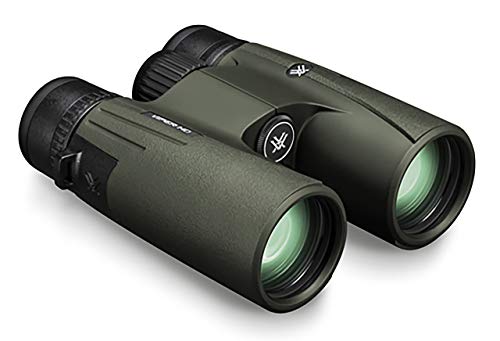We have asked several avid hunters which hunting gears they won’t forget during deer hunting. Most of them replied with a simple answer – ” Firearms, bows, pocket knife, and a quality pair of the best binoculars for deer hunting.”
But Why Binoculars?
With the best deer hunting binoculars, you can scan your area, see close-up details, and stalk the deer easily that you would never be able to see with your naked eyes.
You can also use hunting binoculars to discover what’s happening in far-off areas and make an informed choice to put in your hunting plans. Clarity and sharpness help you take a better look at the deers and their size. The anti-reflective glass and multicoated lenses produce vivid color which will help you identify if the buck is matured enough, tail feathers, stripes, and spots. Plus, you can identify hazardous animals before they see you and buy the extra time to make the right decision.
However, this doesn’t mean that all binoculars are perfect and will help you in every hunting job. There are still some that might cause you frustration, problems, or anxiety and could be challenging to use for your intended purpose. So to help you decide which binoculars to buy for your next deer hunting, we carefully tested 30+ different binoculars for deer hunting and selected the TOP 6.
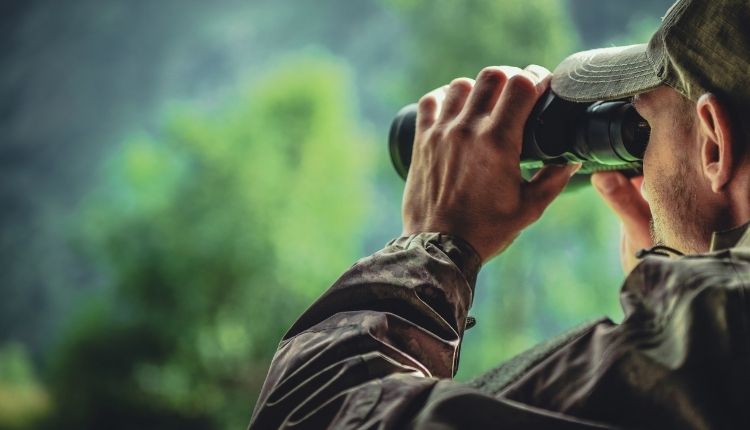
How do we select those top 6 deer hunting binoculars?
First, we looked at the specs of each one and considered how they would perform in different hunting situations. Second, we used a rigorous testing process to compare them side by side so that you can get an objective view of which binoculars are the best for your needs. Third, we evaluated their features, construction, and value for the money.
Also, we only picked those binoculars with the essential qualities important for hunters, such as waterproofing, rugged and robust build quality, multi-coated lens, long eye relief, and correct magnification for hunting.
Why Should You Trust Our Review:
We have over 30+ years of experience in hunting and testing binoculars. So we are confident that we can give you the most accurate information on which models to buy according to hunting type. Furthermore, our team is passionate about helping you find the perfect optics for your needs and ensuring that you get what you are looking for.
All of our reviews are written by someone with a hunting background who knows what you may need and cons to look out for before deciding on buying binoculars. We never publish fake or clickbait lists that might be misleading, so we ensure all the information is gathered from our real hands-on experience and research.
Why Use Binoculars for Deer Hunting?
There are many reasons why you might want to use hunting binoculars for your next big animal hunt. Have a look below to see why using binoculars for hunting is a good idea.
Scan Your Surroundings:
Deer hunting binoculars allow you to scan your surroundings much more quickly and efficiently than if you were just walking around. More importantly, this becomes more helpful when hunting in hilly or mountainous terrain. Scanning a mountainous area can take a long time to walk from one vantage point to another. By using binoculars, you can quickly and easily check the surroundings for any potential game.
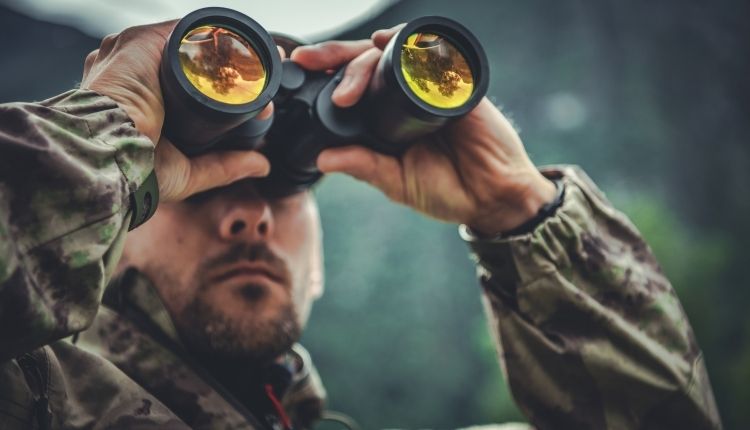
See Animals Close Up:
Hunting with binoculars is a great way to get up close and personal with the game. With the right magnification, you can see the animal’s details more clearly, such as checking the deer’s antlers for evaluating its maturity and other features such as pedicle from far away without having to disturb them. Also to know the difference between the bucks and doe you must use your binoculars. This evaluation process from far away is really crucial and allows you to make better decisions.
Helps To Make Right Decision in time:
With binoculars, you can make better decisions about whether or not to take a shot. For example, pronghorn antelope and grizzly bear restricted hunted species in Washington. And if you can’t see the horns or other physical identifiers from a distance. In that case, you might not know if the animal is eligible for hunting or not. Also, you might know that hunting of antlerless deer or less than 3 inches in length is not allowed during the firearms season or the muzzleloader season (without a few exceptions).
By mistake or inaccurate judgment, if you shot a deer that is not allowed for hunting, you may find yourself in for a hefty fine and/or imprisonment. So having a quality pair of binoculars is a lifesaver as well as a great way to enjoy your hunting trips without any hassle.
Accessible in Difficult Conditions:
Hunting binoculars are often accessible under challenging conditions. For example, hunting elk can be challenging in dense forests and tall grassy areas. You may also find challenging to find the mule deer buck. However, with a quality pair of hunting binoculars, you can spot those telltale signs that indicate where the game is likely to be without having to hike for miles.
Avoiding Hazardous Animals:
It is essential to be aware of the potential dangers that can come with hunting. For example, dangerous animals like bears and cougars can quickly become agitated if they feel threatened. If you’re not prepared for this kind of situation, it could result in severe injury or death. Hunting binoculars can help you avoid situations like these by providing a clear view of the animal from a safe distance.
What Are The Types of Binoculars Based On Prism and Other Technology
There are a few different hunting binoculars, each with its unique features and benefits.
Roof Prism Binoculars:
Roof prism binoculars are a type of binocular design that uses overlapping internal prisms to create an H-shape. This design makes the objective lenses line up directly with the eyepieces, resulting in an overall slim and streamlined shape.
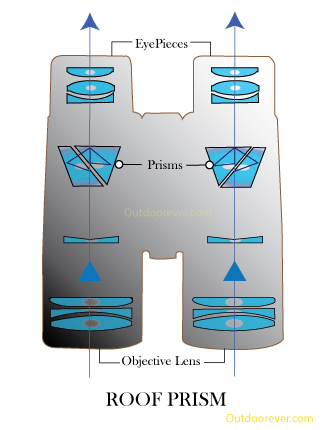
Additionally, roof prism binoculars tend to be more rugged and compact than other types of binocular designs because they have less bulk and weight. However, roof prism binos are more complex than Porro prism designs, making them more costly to manufacture. As a result, they are pricier than other Porro prism binoculars.
Porro Prism Binoculars:
Porro prism binoculars are the most common type of binoculars on the market. They use a zig-zag design where the objective lens is offset from and not in line with the eyepiece. As a result, the viewer has a broader field of view angle and can see more details than with other types of binoculars. But they are larger, bulkier, and heavier than other types of binoculars. As a result, Porro prism binoculars may not be the best option for those who want to take them hunting or other activities where portability is important.
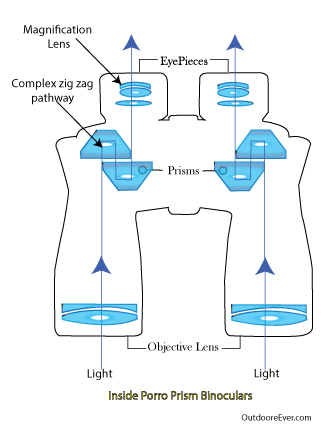
Low Light Or Night Vision Binoculars:
Low light or Night vision binoculars use unique imaging technology to allow people to see in the dark. This technology follows the principle of creating an image when light waves pass through a lens and are focused on a screen. Night vision technology uses photon-enhancing elements to amplify the light waves and create an image that can be seen.
The main difference between night vision binoculars and regular binoculars is that night vision binoculars use a special filter to allow viewing in low-light conditions. This filter allows more light to enter the eye, making it possible to see details at a distance that would be difficult or impossible to see with regular binoculars. This type of binocular is particularly helpful when hunting in dark or dimly lit areas or when you need to see details at a distance that other types of binoculars cannot. However, night vision binoculars are more expensive than other types of binoculars thus may not be the best option for most individuals.
Difference Between Full Size and Compact Binoculars
You can generally find binoculars in two sizes: Compact and Full-Size Binoculars. But which one is the better choice?
If we place both full and compact-size binoculars side by side, the most noticeable difference is their size. Full-size binoculars are larger and heavier compared to compact ones. The increased weight is by consequence of a bigger glass and lens, which vary in thickness as well.
Most Compact binoculars have a lens diameter of 28 to 36 millimeters, while full-size binoculars have lens diameters of 40 to 42 millimeters.
The exit pupil is the area that transmits light out of the binocular when viewed from the eyepiece. Generally, In full-size binoculars, the exit pupil is around 5.5, while in compact-size binoculars, the exit pupil is 4. Meaning full-size binoculars are better to use in low light conditions because of the bigger exit pupil.
Both full-size and compact binoculars are made from different materials. Full-size binoculars are usually made of metal such as; aluminum and magnesium, while compact ones are generally plastic. However, the quality and construction of both types of binoculars are highly dependent on the price range that you’re looking at. For example, our reviewed Swarovski CL pocket binocular is an example of a compact bino made out of alloy.
Another difference between full-size and compact binoculars is their eye relief. Eye relief is the distance from the eyepiece to where your eyes are when you look through them. In general, Full-size binoculars have longer eye relief, making them more comfortable to use. In contrast, in compact binoculars, eye relief is shorter, making them unsuitable for those who wear glasses. But there are also exceptions, so it varies from price to brand.
Full-size binoculars are best for most hunting purposes because they offer the best quality and larger exit pupil. However, they are heavier and more difficult to carry around but provide better quality in low-light situations. There are a few exceptions, such as hunting in the mountains where you need to hike wearing heavy clothing and carrying gear. In this case, we recommend compact size binoculars are the best because they are lighter to carry and hold. But generally, full-size is the better option for all low-light situations and other hunting situations.
Tips When Using Binoculars For Deer Hunting
There are a few tips that you can follow to make sure that you get the most out of your hunting binoculars:
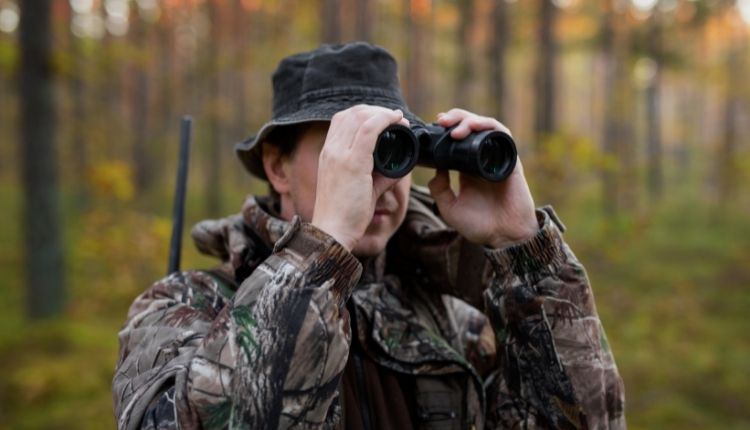
Be Steady and Hold It Firmly:
The first thing you need to do is be steady and hold the binoculars firmly. Being steady and holding the bino firm helps you retain better image quality and ensure that they will not move around while you’re looking through them.
Use a Tripod When Possible:
If possible, always use a tripod when glassing. Using bino with a tripod will give you the most stable platform to view your quarry, resulting in increased accuracy and reduced eye fatigue.
If you’re not using a tripod, your binoculars will shake, and this can make it difficult to see what you’re looking at. So when steadying your binoculars, please take a couple of deep breaths to get rid of any excess energy and hold them as still as possible.
Take Off Binoculars Strap If You are In Bowhunting For Avoiding Noise:
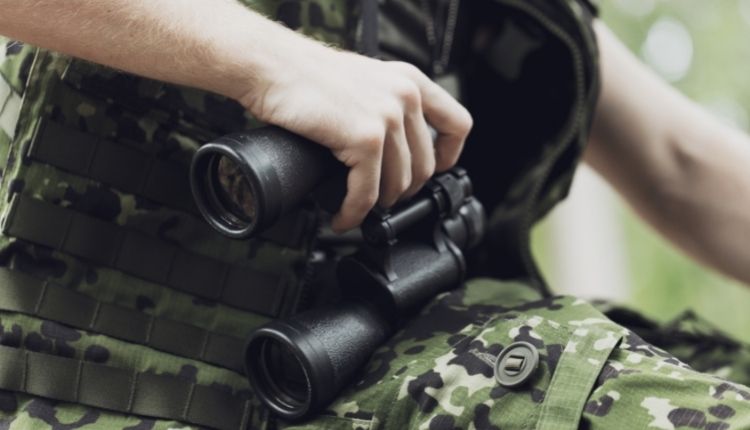
When you are using your hunting binoculars in bowhunting, taking them off of the strap can help to avoid any noise. When the binoculars straps touch the body of the bino or each other, they create a lot of noise.
Try To Keep the Sun At Your Back While Glassing:
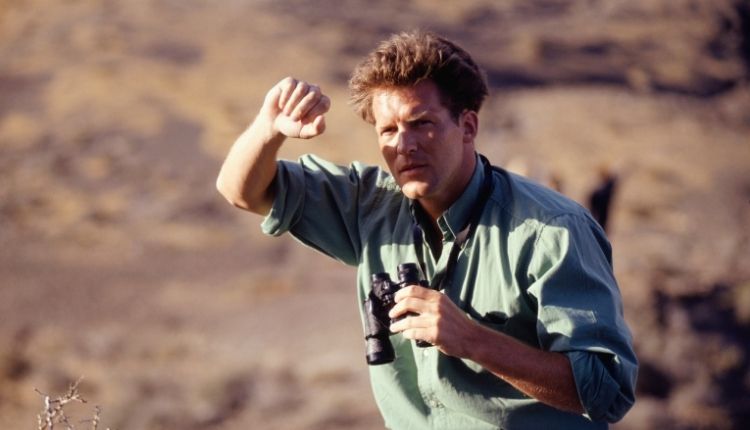
Most people tend to look through the binoculars in a way that allows the sun to hit their eyes. That way is not the best to view your target as you will not be able to see it very well. Try looking at the target while keeping sunlight at your back to improve visibility.
Use a Clean Binocular Lens:
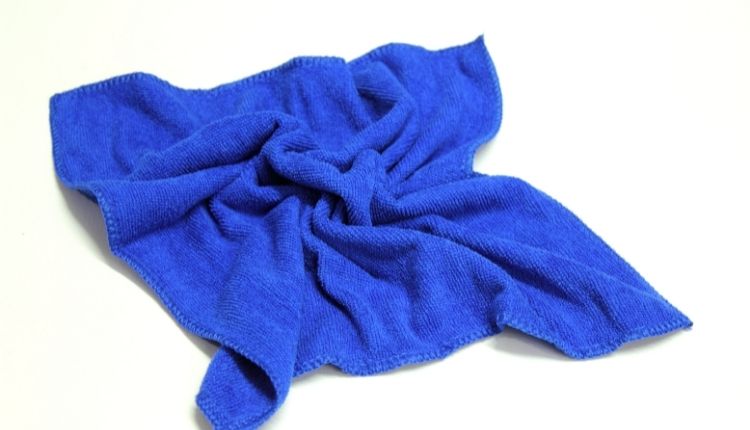
It is important to clean your binocular lenses regularly to get the best view possible. Dirt, tree sap, and other debris can build up on the lens, making it difficult for you to see clearly. Use a lens cleaning solution or a soft cloth to clean the lenses.
Try To Avoid Building Up Fog:
When it is cold outside, your breath and face heat can quickly fog up the lenses on your binoculars. To prevent this from happening, make sure to keep them warm and take them out only when you are ready to glass in.
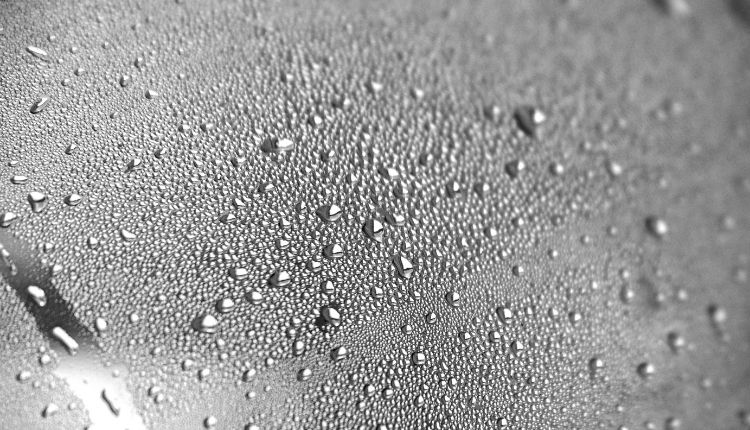
Use the peak of a hill rather than the bottom for better viewing:
Finding an optimal spot to view your target is crucial when looking through your binoculars. For example, to see 360 degrees around you requires a high point or vantage point. To find such a spot, look for a higher hill than the rest of the landscape. The peak will offer you the best vantage point and allow you to see more terrain than if you were looking at it from below.
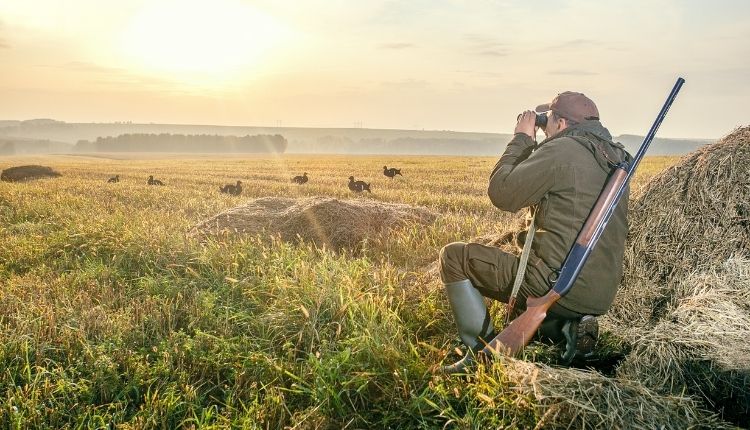
Select the right size:
When it comes to choosing the right sized binoculars for your needs, be sure to take into account both the distance you need to glass as well as your field of vision. Generally speaking, 8×42 and 10×42 binoculars are good for close-up observation, while 12×50 and 15×56 models are ideal for long-range viewing. However, you may need tripod support for using long-range binoculars such as 12×50 as they are pretty heavy.
Which magnification is best for hunting: 8×42 or 10×42?
To answer this question depends on a few factors, including the distance you are looking at and how steady your hands are. Generally speaking, 8×42 binoculars will give you a good overview of medium-sized games. At the same time, 10×42 models will offer improved detail and resolution for larger prey.
However, it is always important to test out different magnifications to see what works best for your specific needs. For example, the main advantage of having 8×42 binoculars is it’s less prone to shakiness and blur. At the same time, 10×42 is perfect for those who like to glass from a steadier position and have better control over the magnification.
Review Of The Top 6 Best Binoculars For Deer Hunting
Below we shared our opinion about the top 6 best binoculars for deer hunting. So Without further ado, let’s get started!
Review of Vortex Optics Diamondback HD 10×42 Binocular
After extensively researching the options, we think that the Vortex Optics Diamondback HD 10×42 is one of the best choices for anyone looking for a good pair of binoculars for hunting. 10×42 size is more than enough to see clearly at a distance. Plus, the HD optical system provides excellent clarity and color reproduction even at dusk.
First and foremost, this binocular features a Bak 4 roof prism with dialectic coating and phase correction technology. These features ensure that image contrast is not diminished due to how light travels through the prism and produces a crisp, clear picture. Additionally, the rubber armor magnesium housing makes it very durable and lightweight. Weighing just 1.33 lbs. is perfect for long outdoor excursions or vigorous hunting.
We found the side stippling to be very helpful in gripping this binocular even in wet weather. In addition, the reliefs cut into the underside make them easy to hold even while wearing gloves. Vortex crafted this binocular with ergonomics in mind, and they are extremely comfortable to use for extended periods. Plus, the larger hinge distributes forces throughout the length of the binoculars for improved durability. With all these features combined, we think that the Vortex Optics Diamondback HD 10×42 Binocular would make an excellent choice for any shooting or hunting enthusiast.
The field of view is listed at 330 feet/1000 yards, and the angular FOV is 6.3 degrees, which is plenty of coverage for most purposes, and you can see everything in front of you with ease. Finally, close focus capability is 5 feet, quite exceptional to get from this price range of binoculars.
The 15mm eye relief is excellent for people who wear glasses. The easy-accessible center focus knob helps us to focus the image easily to get a perfect image – even when wearing gloves. In addition, you will find the diopter adjustment in the right eyepiece to fix the individual eye focus.
For more protection and to prevent moisture from building up, this binocular is also O-ring sealed and argon purged.
Now, let’s talk about the downsides. First, we noticed about this binocular that the edge focus seems to suffer slightly compared to some higher-end models. However, it wasn’t noticeable when imaging specific objects or animals, and overall lens performance remained excellent. Plus, this binocular shows more heatwaves than some of their competitors. Finally, glassing white areas can be a little bit distracting at times. But we think these are negotiable compromises for the increased comfort and stability they provide in an affordable price range.
Finally, if you are looking for the best bino that will provide you with everything you need and more for deer hunting. The Vortex Optics Diamondback HD 10×42 binoculars are worth considering.
Review Of Athlon Optics Midas 8×42 ED Binoculars
The Athlon Optics Midas 8×42 Binocular is an excellent choice for avid deer hunters, birdwatchers, and nature lovers. It offers good image quality, exceptional build quality, close focus capability, and a comfortable viewing experience.
One of the things we liked about this hunting binocular is the high level of detail that it can capture. Whether you’re looking at the deer far away or up close, you’ll be able to see every detail with this binocular. Another great feature is the close focus capability, which allows you to look at objects closely without moving away from your location.
Athlon uses ED or extra-low dispersion glass in this binocular, which significantly reduces the amount of chromatic aberration in your image. This Ed glass produces a brighter, sharper image free from distracting shadows and lines. Also, the BAK-4 prism is coated with an ESP (Enhance Spectral Prism) dielectric coating, which increases the light transmission and reduces glare. In addition, the Advanced Fully Multi-Coated lense prevents light distortion, provides superior light transmissibility, and ensures that colors are accurate and true-to-life.
Like the Vortex Optics Diamondback HD 10×42, it also uses prism phase correction coating to eliminate the shortcoming of roof prism technology. The eye relief of Midas is 17.2mm more than enough for comfortable viewing. The field of view is 426 ft. for 1000 yards which is quite a bit wider than most other hunting binoculars on the market at this price range. But when we compared the weight of this binocular with the Vortex Optics 10×42 Diamondback HD is a bit heavier at 1.57 lbs, so it could be a downside for some people.
The exterior of this bino is made from a durable non-slip rubberized material. This rubber material provides a secure grip in any weather condition and makes it resistant to scratches and dings. In addition, the magnesium chassis gives these binoculars a very strong and sturdy feel while reducing the weight by as much as 35% compared to other comparable models.
Athlon uses argon purging to prevent water or wind from coming in contact with the internal workings. This feature makes it a waterproof and fog proof design that will stand up to even the harshest weather conditions.
Talking about cons, one of the potential issues that could come up is with the focus wheel in cold weather. When we tried this bino out below the freezing temperatures, the focus wheel became quite difficult to turn and made an unusual squelching noise. Plus, the close focus range is only 3 meters, a bit disappointing where Vortex Optics Diamondback HD 10×42 offers almost 5 feet or 1.52 meters of close focusing distance.
Review Of Vortex Optics Viper HD Roof Prism Binoculars 10×42
Are you looking for a deer hunting binocular that is more powerful than the Vortex Diamondback series? Then Viper HD Roof Prism 10×42 Binocular is definitely worth considering. Not only do they offer an impressive 10×42 magnification and wide field of view (341 feet). But also their Premium extra-low dispersion glass makes them capable of capturing vivid imagery with clarity and precision.
Comparing vortex viper and diamondback side by side we found that diamondback features an HD lens system optimized with select glass elements. In contrast, Vortex viper has HD Lens Elements. From there, we can see that the viper offers superb glass quality and clarity that is hard to beat. However, it’s important to remember that the diamondback series is a bit cheaper, so if you are looking for a budget-friendly binocular, the diamondback may be a better option.
Viper also comes with a superior XR™ Fully Multi-coating and phase correction coating. These coatings make this bino resistant to glare and reflections, making it ideal for viewing in bright sunlight or difficult viewing conditions. In addition, with its high-quality twist-up eyecups, extended 17mm eye relief, and well-placed eyepieces, you’ll have no trouble getting a good view from any distance. So even if you are a glass wearer, you’ll be able to use these binoculars comfortably.
The Vortex Optics Viper HD Roof Prism binoculars offer a close focus of just 6 feet, great for viewing things up close and in detail. This feature makes them perfect for deer hunting, birding, or exploring the outdoors. Not to mention, the 6-foot close focus allows you to follow nearby but hidden hunting prey without having to move too far away from it.
The Viper HD Roof Prism Binoculars have a locking diopter placed in the right eye. This diopter ensures that each barrel is explicitly focused on your eyes, making it easy to get a perfect view no matter what you are looking at. In addition, the center focus wheel provides quick and easy control of the focus, making sure that you have sharp views without any fuss.
The Vortex Optics Viper HD Roof Prism Binoculars come with argon purging, which means that the binoculars are resistant to water and shock. This protection feature is great for when you are out in bad weather or plan on deer hunting in wet conditions. The binocular also comes with an armortek on the exterior glass for protection from scratches, oil, and dirt.
The Viper HD Roof Prism binoculars come with a quality chest harness for convenient and comfortable viewing. This harness not only securely holds your binoculars in place but also makes it easy to carry them around wherever you go. The straps are adjustable for a perfect fit, and they make sure that the binoculars don’t move around while you are using them.
At the time of our testing, we found slight chromatic aberration in the Viper HD Roof Prism Binoculars. However, they exhibited good resolution across most of their viewing field. The only downside is that these binoculars display a little bit of purple fringing in high contrast.
Despite the cons, if you need a top-notch mid-price point roof prism binocular for deer hunting that comes with a good amount of features, the Viper HD Roof Prism Binoculars should be at the top of your list. We seriously can’t say enough good things about these hunting binoculars, and they are definitely ones that you will enjoy using.
Review Of ZEISS Terra ED Compact 10×42 Binocular
ZEISS is a well-known german optical company that produces high-end binoculars and other optics products. They have been producing binoculars for hunting and birding for more than 100 years. The ZEISS Terra ED Compact 10×42 binocular is one of their best entry-level binos at an affordable price point. But don’t let the price fool you – these binoculars are exceptionally good, especially for the price.
We quickly realized that they were built like tanks when we first tried them out. They have an excellent feel, and their weight is just right – not too heavy, but not light either. The ocular adjustments were easy to use, and the focus was definite and smooth. We found them to be very easy to use in cold weather, which is a big plus – especially if you use these binoculars for deer hunting in cold environments.
The image quality was simply amazing – no loss of color and very crisp. The viewing distance was also great, providing a nice clear image at long distances.
The size of these binoculars is perfect for hunting and birding. They are about 4.5 inches by 5.5 inches and weigh a little over 25 ounces, identical with vortex viper 10×42. They fit easily in your hands, which is a plus if you hunt in those tricky close-to-the-ground situations.
The Zeiss Terra ED binoculars are water-resistant, not waterproof. However, we found that these binoculars are water-resistant to 100 Millibars from the Zeiss website. And we know 100 Milibars equals 0.1 Bars which is equivalent to 3.35 feet of water means you can not submerge these binos. But they can withstand light rain or snow easily.
These binos can project exceptional detail of what you are looking at in low-light. Seriously We were really impressed with how well they did in poorly light, such as dusk or dawn. The Twilight factor is 20.5, meaning these binoculars will project more detail under very low light conditions than most other binos.
The field of view of this 10×42 hunting binocular is 330ft @ 1000 yards which is great for all sorts of deer hunting and birding applications. Plus, the close focus distance is 5.3 ft, so you don’t have to get too close to your subject to see it clearly.
With all the good things said about these binoculars, a few things to mention might not be perfect for everyone. First off, the eye relief length is 14mm, which might be a little too short for some people, especially for the eyeglass wearer surely face some problems. Second, we did not like the carrying bag; however, few of our friends appreciated its design.
So if you are looking for a compact yet powerful binocular for deer hunting, the Zeiss Terra ED 10×42 model is still an excellent choice. This binocular is a steal deal that offers incredible detail in low light, a good field of view, and close focus distance.
Review Of SWAROVSKI 10×25 CL Pocket Binoculars
Hunting mountain bucks, goats, or bighorn sheep can be a rewarding experience. But getting a close-up view of these animals can be difficult with full-size binoculars. The SWAROVSKI 10×25 CL Lightweight Pocket Binoculars are designed for just that purpose – getting up close and personal without having to carry around an extra set of heavy equipment such as a tripod.
After Carl Zeiss, Swarovski is the second oldest binocular manufacturer globally. They started producing optics in 1895 and continue to be one of the leading manufacturers today. Swarovski is well renowned for making premium optical gears for hunters, birdwatchers, hikers, travelers, and other outdoor enthusiasts.
The 10×25 CL Pocket Binoculars are a great option. These binoculars have a compact, lightweight design that makes them easy to carry around. In addition, the weight of this foldable binocular is incredibly light, only 1 pound. This lightweight feature helps to reduce the fatigue you may feel from holding a binocular for an extended period.
The 10x magnification on these SWAROVSKI pocket binoculars gives you a clear view of your target. So whether you are mountain deer hunting, elk hunting, or observing nature, these binoculars will provide you with the clarity and detail you need to make the most out of your viewing experience. Also, most of the mountain deer hunting is done under the bright sunlight. So you don’t need to have a large objective lens to gather light. For that reason, you can say 10×25 is the perfect size for mountain buck hunting binoculars.
The angular field of view on these binoculars is 5.6 degrees, and the linear field of view is 294 ft/1000 yards. These compact bino give you a decent view even when looking at objects from a distance. With this field of view, you can see more details in the landscape or detect your target faster in hunting scenarios. The focusing wheel is a little slow located in the center, has smooth handling, and is very easy to use. Don’t take slow-focusing as a problem because slow-focusing is best for hunting. With the help of a slow-focusing wheel, you can easily follow your prey’s movement, and it’s tough to miss a target if you have good focus.
The optical performance of these binoculars is outstanding, and they have an impressive light-gathering ability. With 88% light transmission capability, these binos can give a hard punch in viewing during brighter light. All the lenses are fully multi-coated with Swarovski’s bright technology that helps to project the most impressive images. In addition, the glare reduction coating on these binoculars helps reduce the amount of reflection off surfaces, making them perfect for sunny days.
Talking about eye relief, you will surely get surprised by these binoculars. With a long 17mm eye relief, these binos are definitely the winner in terms of eye relief. We tested lots of pocket-size binoculars, and most of them have eye relief in between 12mm to 14mm. But these CL binoculars deliver a whopping 17mm of eye relief, which is perfect and a blessing for those who wear glasses.
These pocket binoculars are 11 cm in height and 10 cm in width. With such a small form factor, they can easily fit into a pocket or a pack. But don’t be confused by their small sizes. These binoculars are built with the highest quality and performance in mind, so size doesn’t matter.
The housing of the binoculars is made out of a lightweight, durable aluminum alloy. This makes these binoculars very sturdy and can handle any weather or terrain you might encounter while hunting. In addition, thanks to the dual-hinge design, you can easily fold the binoculars together for easy transport and storage. You also have a wide variety of interpupillary distances for the dual hinge system, which is excellent for different individuals.
The green finish on these binoculars gives them a sleek and sophisticated appearance, making them perfect for any type of hunting or nature observation. In addition, the nitrogen filling in this optic allows you to work in even the coldest weather conditions without experiencing fogging or reduced performance.
The operating temperature range for these binoculars is -25 to +25 degrees Celsius, making them ideal for various applications. The 10×25 CL Pocket Binoculars are also fully waterproof to a depth of 4 meters of water, making them perfect for use, from hunting and fishing to bird watching.
Now it’s time to give some opinion about what could have been better. one of the few downsides to these binoculars is their stiff price tag. For this reason, they may not be the best option for everyone. But we can say these binoculars are undoubtedly worth the money. However, if you are looking for quality and performance, these binoculars should be at the top of your list. Another thing to consider is that the field of view could have been a bit better. Nevertheless, you are getting a lot of quality in these binoculars; it’s hard to complain too much.
Apart from these, SWAROVSKI 10×25 CL is a superb binocular and would be perfect for mountain hunting, birding, and even general outdoor use. So if you are looking for a top-quality pocket binocular that will offer everything you need for mountain hunting, these are the perfect option.
Review Of Leupold BX-2 Alpine HD 10x42mm Binoculars
If you are looking for one of the best binoculars for deer hunting that is affordable, the Leupold BX-2 Alpine HD 10x42mm binoculars should be at the top of your list. They provide excellent resolution and viewing angles for capturing animal detail in close-up without distortion. Plus, their rugged construction means they are good to use and abuse even in the roughest conditions.
At first impression, design-wise, we find some similarities with the vortex diamondback binoculars. However, they are similar from the outside but not identical in inside construction. Leupold uses a different type of glassing technology than vortex, which is their main USP.
At 10x magnification, the Leupold binoculars have a greater angular field of view of 6.5 degrees (vs. 6.3 degrees for the vortex diamondback). Also, the linear field of view is 342 ft. @ 1000/yds (vs. 330 ft. @ 1000/yds), making them ideal for hunting in tighter spaces or looking at distant objects from a long distance when hunting big game.
The Leupold binoculars provide excellent clarity at all magnification levels. As a result, you will see phenomenally clear images in even the most challenging hunting conditions. In addition, the lens is made from specially formulated calcium fluoride glass, ensuring incredible clarity at all magnification levels. This glassing technology lets you view distant objects with amazing detail and accuracy.
Talking about weight, we find Leupold is slightly heavier than the vortex, but it’s not a big deal. Actually, at 1.75 lbs., they are pretty light for 10x binoculars and easy to hold or more convenient when mounting on your tripod. The eye relief is quite generous, too; at 15mm, most users would find it comfortable to use.
The lens coatings on these binoculars are one of the most important features. The optics are backed with BAK4 prism fully multi-coated. Also, the scratch and smudge-resistant coating helps to resist fingerprints, dirt, and even water droplets from building upon the surface of the lenses. So in harsh hunting conditions, you can be entirely sure your optics will remain operational and clear.
Finally, these binoculars are also waterproof and fog proof, so you can take them trekking or hunting in inclement weather conditions with complete confidence. According to the Leupold website, they can endure a depth of 33ft. and numerous pressure changes.
Now lets talk about what we don’t like about these binos. We find they have a warmer yellow cast compared with other similar priced options. But that is only noticeable when you compare them side by side with another bino which is not realistic in the real-life scenario.
All in all, we think these Leupold BX-2 Alpine HD 10x42mm Binoculars are the perfect choice for the discerning hunter. So if you are looking for quality optics that will withstand even the most challenging deer hunting conditions without spending arms and legs grab this Leupold Bx2.
Factors To Consider When Choosing the Best Binoculars for deer Hunting
Quality:
Quality is always the first factor to consider when choosing binoculars for deer hunting. The higher the quality of your optics, the better they will perform in low light conditions and provide you with a clearer image.
Also, it is worth considering that there is a close relation between price and quality of glass used in binoculars. Therefore, when searching for a high-quality pair of deer hunting binoculars, note that the more expensive models are usually made with premium glasses. Some of the premium binoculars brands or manufacturers are Zeiss, Nikon, Swarvoski, Leica, Bushnell, etc.
In addition to glass, it is also essential to look at other aspects like lens coating, which protects against fogging and offers better contrast. Furthermore, having lens coating in the bino makes them perfectly suitable for hunting under adverse weather conditions (rain, wind).
What is Magnification in Binoculars:
The magnification of a binocular is the power of the lens to enlarge an image. The higher the magnification, the closer you can see details in an object. For example, 10x magnification power will make the view through the binoculars appear 10 times closer than it appears to the naked eye.
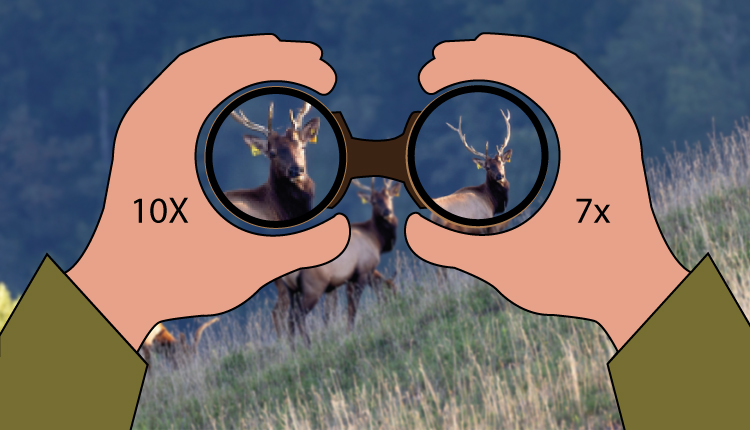
For deer hunting purposes, you can choose magnification ranging from 6x to 12x. But remember, as you increase magnification, your field of view will also be reduced. So, it is crucial to make a preliminary check on your target. If you use lower magnification for better resolution, then increasing the number may not be necessary.
The magnification of a pair of binoculars is key for assessing their suitability for hunting purposes. Most hunters prefer 10×42 models as they offer improved detail and resolution over 8×42 models. Still, it’s always wise to test out different magnifications to see what works best for your specific needs.
For example, for medium-sized prey, 8x magnification should be adequate, while 10x offers increased clarity when viewing more giant games such as deer or moose. It is also worth bearing in mind that higher magnifications tend to be prone to shakiness and blur, making them more suited to surveying and long-range observation.
What is The Objective Lens Of Binoculars:
The objective lens of a binocular is the largest and most important lens. It collects light and transmits it to your eyes. In high-quality binoculars, each objective lens is typically manufactured of two separate glass elements: Crown (top element) and Flint (bottom element).
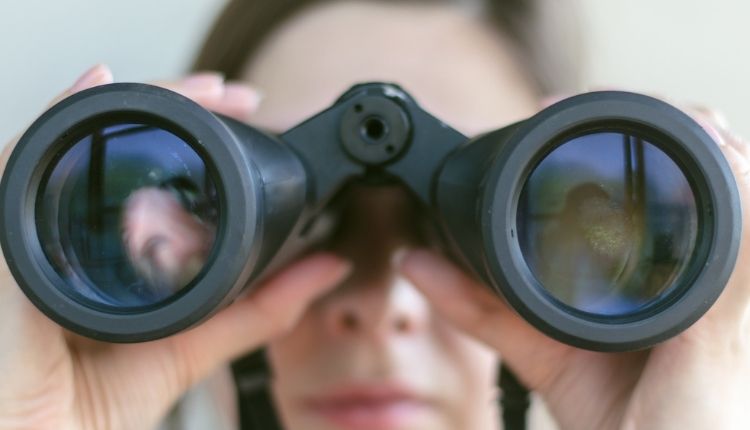
Now you can ask what is 42 or what is 50mm and what are the main difference between these numbers?
The main difference between the 42mm and 50mm objective lens sizes is that the 50mm objective lens gathers more light than 42mm. Therefore, the 50mm will be better for viewing targets in early or late hours when there isn’t as much light. Additionally, a 42mm Objective Lens has less distortion in the field of view and better peripheral illumination. So, in short, the larger the objective lens, the better it will be at gathering light and resolving detail.
What is Exit Pupil in Binoculars:
If you carefully hold and look at your binocular from around 25cm away, you will see a tiny circle in the center of each eyepiece; this is the exit pupil. If your binoculars have larger exit pupils, you will get a brighter view in darker conditions.
The larger the exit pupil, the brighter your field of view will be, which is essential when observing faint objects or viewing landscapes at night.
To calculate the exit pupil size, simply divide the objective lens with magnification power. For instance, the exit pupil of 8×42 binoculars has 5.25mm, whereas 10×42 binoculars have 4.2mm. From here, we can say the higher the magnification power, the smaller size of the exit pupil.
Relative Brightness Index?
The relative brightness index (RBI) measures binoculars’ ability to resolve detail and brightness as seen from a given distance. The higher the RBI, the better the binoculars perform in low-light environments.
The relative brightness index is calculated by squaring the diameter of the exit pupil. This number will give us a better indication of how well binoculars will perform in low light. To calculate RBI, simply divide objective lens size by magnification power and then square the result. For instance, 8x42mm binoculars have an exit pupil of (42÷8) = 5.25, and squaring 5.25² results in an RBI of 27.6. At the same time, 8x50mm binoculars have an RBI of 39. The summary is if the magnification power is the same, the larger the objective lens diameter, the better resolution we will see.
Check The field of view
The field of view (FOV) is the measured width of the scene you can see when looking through your binoculars. In binoculars, there are two ways to measure the FOV:
- angular and
- linear.
The angular field of view is the real angle seen through the optics, while the linear field of view is how wide or long an area is seen at a given distance. The higher the angular FOV or Linear FOV number, the more area you can see at once. So if you are looking for hunting binoculars, look for binoculars with a high FOV because it will give you a chance to see more of the scene in front of you.
To calculate the linear field of view, simply multiply the angular field by 52.5. For example, if your binocular has an angular field of 10° and a linear FOV at 1000 yards will be 525 ft. (10 x 52.5).
One thing to remember is that magnification plays a significant role in FOV. Higher magnification will result in a smaller FOV. So a 10x binocular with a 40mm objective lens will have a much smaller FOV than an 8x42mm binocular.
How much Eye Relief Does It Offer?
Eye relief is the distance from the eyepieces to where your eyes can comfortably look without feeling strain. It’s important to find deer hunting binoculars with as much eye relief as possible because you won’t have to move your head much when looking through them. In addition, extended eye relief reduces fatigue and allows for longer viewing sessions.
Generally, bino with a longer eye relief will give you more natural peripheral vision. To find your bino’s eye relief, take the magnification of your binoculars and divide it by objective lens diameter number. For example, if you have a 10x binocular with a 40mm objective lens, the eye relief would be 4mm.
What kind of Prism Used in That Binocular
Prism is the special feature in binoculars that makes an inverted image look upright. Prism binoculars rectify an inverted image projected by the objective, shortening the optical path. With this technology, manufacturers now can make more compact binoculars than before. There are two types of prism binoculars: Roof Prism type and Porro prism type. We recommend you choose roof prism binoculars for their lightweight and compact body for hunting purposes.
What Type of Optical Coatings Use There
Optical coatings are the special treatment applied to lenses of binoculars to reduce the reflection of light at the glass surface and allow more light to pass through. This can effectively increase transmission, giving you brighter images with less distortion. There are many different types of optical coating, each designed for a specific purpose. Some common coating types are:
Coated:
If you a see binoculars manual where it says “coated,” this means that the binoculars have been coated with a single layer of anti-reflective coating on one or more lenses.
Fully-coated:
Fully-Coated binoculars have been treated with a single layer of anti-reflective coating on both lenses and the prism. It is upgraded to only coated binoculars and delivers better image quality and less reflection than coated binoculars.
Multi-coated:
It is upgraded from fully-coated options where at least one lens or more has been treated with multiple layers of anti-reflective coating. This provides better image quality and reduced reflection than fully-coated binoculars.
Fully Multi-Coated:
This is the best kind of coating, and it has been treated with multiple layers of anti-reflective coating on all glass surfaces. As a result, it delivers the brightest, sharpest, and most contrasted images possible. Try to buy fully multi-coated binoculars or phase coating binoculars for better visibility in hunting and birding situations.
Phase Correcting Coated:
Without phase correction coating, roof prism binoculars can produce dull or lower image contrast because of the way light travels through the prism. The roof prism assembly diverges light by wavelength. The resulting “muddy” image is due to the reflection of these diverging waves from the prism’s surfaces.
The phase correcting coating is applied to one surface of the shorter light path half of the prism for correcting the roof prism binoculars’ shortcomings such as color balance and fidelity.
In this technology, the phase of the light that traveled the long path is corrected. So it once again matches the light that traveled through the shorter path.
This causes a significant increase in brightness, color accuracy, and contrast. Phase correcting coating is not required in the Porro prism binoculars for their simplified design.
Twilight Factor:
The twilight factor is simply a metric to compare binoculars in low-light situations. It considers how much detail you can see with the naked eye in conditions of reduced illumination. Don’t be confused with how much light the binoculars can gather; it’s all about how much detail you can see in low light conditions. This twilight factor is really essential and crucial for identifying the deer to hunt.
The higher the Twilight Factor, the better quality optics are present inside the binoculars. The twilight factor can be calculated by multiplying the magnification (x) and the objective lens size (y) and square root them to get the Twilight Factor: Twilight Factor = Square Root of (Magnification x Objective Lens Size)
Focus and Adjustable Diopter For Better View
There are two types of diopter available in the binoculars industry for focusing an image. One is an independent focus, and another is a central focusing system.
An adjustable diopter or independent focusing system enables users to focus on each eye separately, vital for anyone with different acuity in their right and left eyes. Setting up focus on each eye ensures you get the most precise image possible.
Nowadays, most hunting binoculars for deer come with an adjustable diopter, which helps you fine-tune your viewing experience. When you are using a pair of binoculars for the first time, adjust the focus of the left eye using the focusing ring and then do the same for the right eye rotating the diopter adjustment knob on the right eyepiece. This diopter knob will ensure that you have a clear and crisp image from both eyes, regardless of your acuity or degree of myopia in one or both eyes.
If you are using a zoom binocular, remember to set the magnification at its maximum before focusing it. This will ensure that the image is in focus from all directions.
If you can’t find the diopter adjustment knob in the bino’s right eyepiece, it is probably on the left eyepiece. Different manufacturers place the diopter adjustment ring on different eyepieces, so check your binocular thoroughly.
If you choose binoculars under 100 dollars, you may find only a focus adjustment knob or a central focusing knob, enabling you to blur or sharpen both barrels at once. As a result, you will have to recalibrate your binoculars each time you change from bird to person viewing distances.
Check Is the Image Sharp enough?
We already discussed image quality highly co-related with the technology of making the bino, the type of glass used to make them, and the type of anti-reflective glass coating used. So to get the sharp, crisp image try to get binoculars for deer with high-quality lenses and coatings.
Check The Portability (Size and Weight) Of That Binocular
A significant factor when looking for deer hunting binoculars to use in the field is portability. You want something that you can easily carry with you, whether it’s a pair of standard-sized binoculars or compact models.
Hiking or hunting in densely wooded areas requires lots of physical activity. Therefore, having lightweight binoculars or hunting gear is the key.
In addition, consider the weight of your binoculars; some are significantly heavier than others. If you’re looking for a set of binoculars that you can take camping or hunting on long hikes, make sure to consider the weight and size of the model before making your purchase.
As you already know, the larger lens on the binoculars will capture more light and make a brighter image. But in a trade-off of that, you may have to deal with the extra weight and size. So it really comes down to what type of activities you will be using these binoculars for and your priorities regarding image quality vs. portability.
From our real-life deer hunting experiences, we have found that the binoculars that offer the best combination of both image quality and portability are 10x42mm or 8×42 lens size. These give you plenty of brightness without dealing with extra weight or size.
But If you are a North American mountain deer hunter or preferred to hunt from the hilly side. We recommend choosing more lightweight and compact version binoculars such as 25-32mm. These sizes of binoculars are lighter and smaller than the 42mm but still offer good image quality since mountain hunting is largely performed under bright sunlight.
Check if the Binoculars is Waterproof:
Most binoculars are weatherproof but not waterproof. So if you have a plan to hunt deer in the rainy season, make sure they are waterproof before making your purchase. Also, keep in mind that most optics lenses can fog up if exposed to moisture, so it is also essential to consider the model with a fog-resistant lens coating.
Check if the Binoculars is Enough Rugged
Hunting in the wild involves a lot of walking and moving around. So make sure the binoculars you are purchasing are rugged enough to take all the abuse your outdoor lifestyle will throw at it. Also, look for armored rubber housing models; this ensures that the optics stay unscathed during those long hikes and pack downs when packing up camp.
How Affordable The Binoculars?
In 2016 hunters spent almost $7.1 billion on firearms, licenses, and equipment such as decoys, optics, blind and more (Ref: 1). This means that when it comes to spending your hard-earned money on hunting gear, you want to make sure you are getting the best value for your dollar. One of the most important factors is how affordable they are when looking at binoculars. You don’t want to end up regretting buying a more expensive model only to find out that it is not compatible with your preferred hunting technique or doesn’t offer superior image quality.
Choose Binoculars According To What Type of Hunting Do You Do?
If you are a waterfowl hunter, you need to consider a binocular with a larger field of view. For example, 8×42 is ideal for tracking ducks in flight but may be too small if you are looking to survey large areas for the game. For the big games such as deer or elk hunting, 8×42 or 10×42, or even 12×50 is what you will want to consider.
But remember, as you increase the size of the binoculars, you are welcoming more weight to hold and shakiness when handling them in challenging situations. Also, heavily weighted binoculars can cause fatigue over time, so make sure you are comfortable with carrying them around all day.
In mountain hunting, there involves lots of traversing up and down mountainsides. Therefore, choose a lightweight binocular, which is perfect for stalking and bringing down big game from far away without spending too much time focusing on the target. For mountain hunting, choose 8×30 or 6×30 size binoculars.
Does it offer any Hunting Specific Features
Everyone loves extra or more than average features in their gear, especially when it comes to deer hunting binoculars. Some top-notch high-end binoculars are specially made for deer hunters, considering the necessary features for accurate and proper observation. But remember that these additional features can come at a cost. Some of the features that are specifically designed for hunters are:
- Laser Range Finder: Some high-end hunting binoculars come with a laser range finder which is great for quickly and easily determining the distance of your prey. This can be extremely helpful when you’re stalking a game or planning to shoot from a long distance.
- Image stabilization (IS) is another feature found on some top-of-the-line hunting binoculars. IS keeps the image steady when binoculars come with high magnification, which can be invaluable when tracking the game or evaluating the prey size and maturity.
- Tripod Adapter: Many hunting binoculars come with a tripod adapter so that you can use them hands-free. This is great for steadying the binoculars while you take aim or track your prey.
Check Online Reviews and What Other Says:
It is evident that online reviews are critical when shopping for anything online, let alone binoculars. Reading the reviews of different models can help you determine which ones are the best suited for your specific needs. You should also pay attention to what other outdoor enthusiasts says about particular hunting binoculars. Those comments and reviews will give you a broader perspective on the product and help you make an informed decision.
Color choice of binoculars:
Color choice is a personal preference, so it is ultimately up to you which color you choose. However, some people feel that hunter-grade binoculars should be black or dark in color for optimum look and stealthy operation. But some hunters preferred to buy deer hunting binoculars in camouflage to help conceal themselves when stalking game. So whatever color you choose, make sure it’s something that will blend in with the environment and give you an advantage when hunting.
What Accessories will you get with the binoculars?
Most of the best deer hunting binoculars come with a tripod adapter and case. In addition, many models include a lens cap, neck strap, and cleaning cloth. The lens cap helps you protect the lenses from dust and other environmental hazards. The neck strap can help stabilize your binoculars when taking aim or tracking movement.
Frequently Asked Questions
Do I need to buy an expensive pair of binoculars to get good results for wildlife observation?
No, you don’t need to buy expensive binoculars to get good results for wildlife observation. You can get a good pair of binoculars for a fraction of the price and still be able to see clearly. The key is to find a pair of binoculars specifically designed for wildlife observation. These binoculars will have a high magnification and allow you to see details that are otherwise difficult to see. Another critical factor to consider is the quality of the optics. The optics should be qualified to see the details clearly without distortion. Ultimately, the most crucial factor in choosing binoculars is how comfortable they are to use. Ensure that you find a pair of binoculars that you can comfortably hold for long periods.
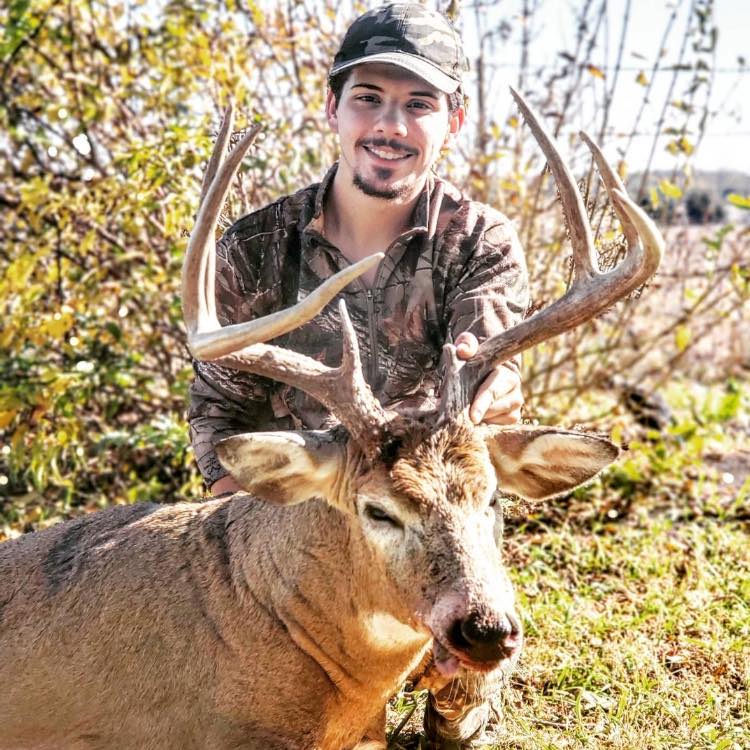
About The Author:
Lake Streeter, A Gun enthusiast, and loves to hunt in the middle of the wood. Always check the latest hunting gears out in the market and try to share his honest opinion with the audience in Hunting Nook.



